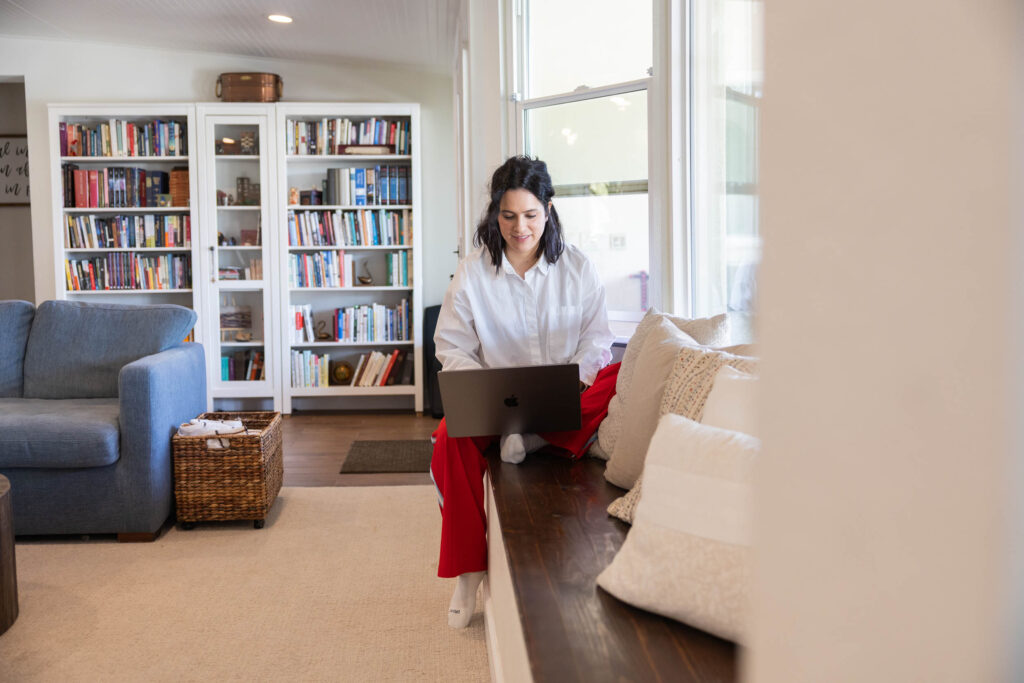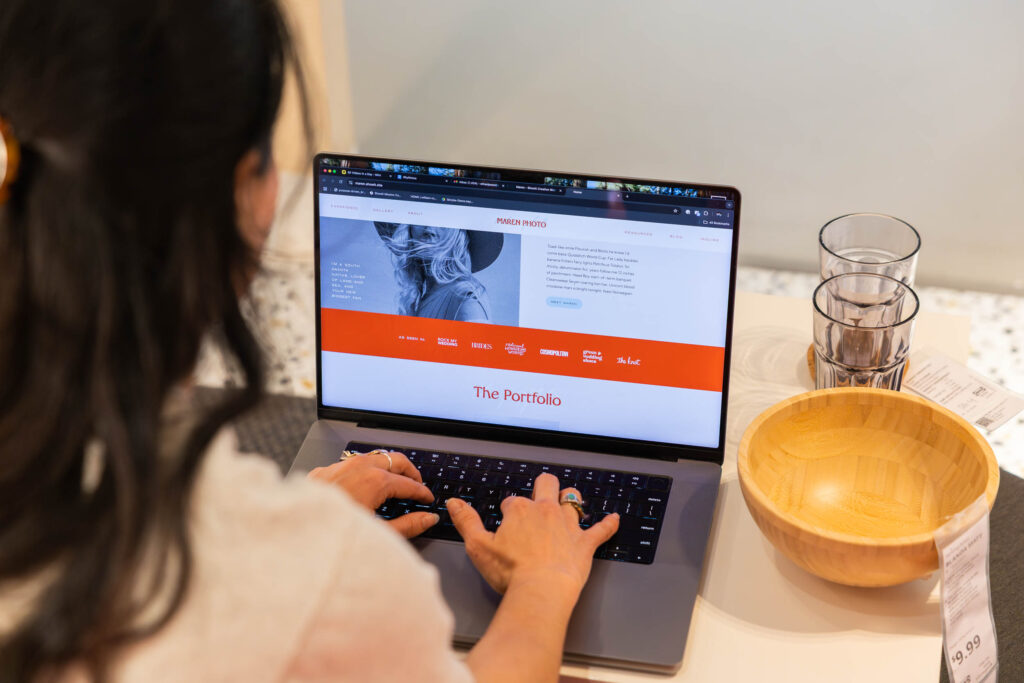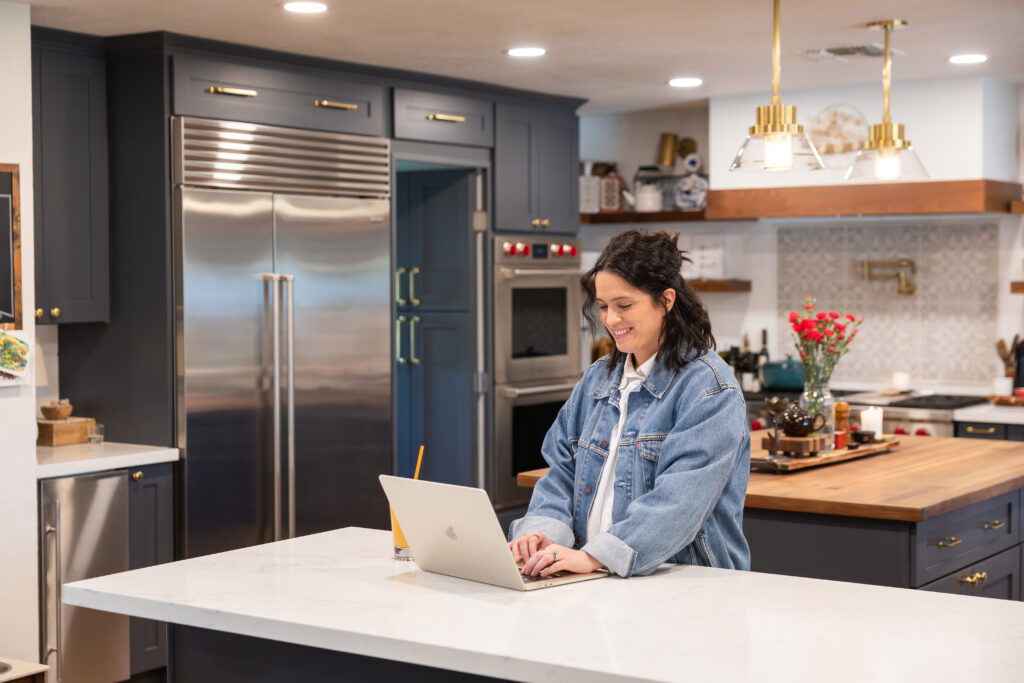You're putting in the hours. You're delivering beautiful work that makes your clients absolutely swoon. Your Instagram feed looks like a work of art, and you know, deep down, that you're incredibly talented at what you do.
So… why are you still stuck in those inconsistent $3K–$5K months?
If this hits a little too close to home, take a deep breath. We’re not judging!
You're not alone in this struggle, and you're definitely not doing anything wrong.
This revenue plateau is something that SO many creative business owners experience, photographers, designers, coaches, copywriters, virtual assistants, you name it.
The truth is, most of us start our creative businesses because we're passionate about our craft. We love what we do, and we're good at it. But somewhere along the way, we realize that being talented and being profitable are two very different things.
Here's what we've learned from watching thousands of creative entrepreneurs grow their businesses: scaling to your first $10K month isn't about working more hours or hustling harder.
It's about working smarter.
You already have everything you need to make this happen. You just need to shift a few key things about how you approach your business.
If you’re ready to finally break through that revenue ceiling, we’re ready to help.

Mindset First, Shift from Hustler to CEO!
Before we talk strategy, we need to talk mindset. Because if you're still thinking like a freelancer, you're going to keep getting freelancer results.
The Freelancer Mindset Says:
- “I need to say yes to every opportunity.”
- “I have to be the cheapest option to get clients.”
- “More hours = more money”
- “I'm just lucky when I get a good client.”
The CEO Mindset Says:
- “I choose projects that align with my goals.”
- “I price based on the value I provide.”
- “Better systems = more money”
- “I attract ideal clients consistently.”
See the difference?
When you're operating from a CEO mindset, you're not just charging more; you're building a business that's designed for sustainable growth. You're thinking strategically about every decision, from the clients you work with to the services you offer.
This shift isn't just about the money (though, yes, it absolutely affects your revenue). It's about creating a business that supports the life you actually want to live.
Here's how to start thinking like a CEO:
Start with the end in mind. Where do you want your business to be in 12 months? What would a typical day look like? How many clients would you be working with? What kind of projects would excite you most? Get clear on this vision, because it's going to inform every decision you make.
Track your numbers like they matter. Because they do. You can't improve what you don't measure. Start tracking your monthly revenue, your average project value, how many leads you're getting, and where those leads are coming from. Knowledge is power, friend.
Set boundaries like a boss. This means saying no to projects that don't align with your goals, even when you're tempted by the immediate income. It means having clear processes and timelines. It means treating your time and expertise like the valuable resources they are.
Invest in your business growth. CEOs invest in tools, education, and systems that help their businesses grow. Whether that's a website that actually converts, a course that teaches you pricing strategy, or a system that streamlines your workflow, invest in what moves the needle.
The beautiful thing about this mindset shift is that it starts working immediately.
The moment you begin thinking strategically about your business, you'll start making decisions that support growth instead of just survival.
Scaling to consistent revenue that you're happy with isn't about doing more; it's about doing the right things on purpose.

Simplify Your Offers to Maximize Revenue
Ok, let's talk about something that might sting a little:
You're probably offering too many things.
(We know this because we’ve seen SO many people do it!)
When you're trying to grow your business, it feels natural to say yes to every type of project that comes your way. Wedding photography AND family portraits AND branding shoots. Custom website design AND logo design AND business cards, AND social media templates.
But here's what we've learned from watching successful creative entrepreneurs scale: complexity kills profitability.
When you offer everything to everyone, a few things happen:
You become harder to refer to. When someone asks your past client what you do, they can't give a clear, memorable answer. “Oh, she does… lots of things?”
You can't become an expert. When you're constantly switching between different types of projects, you never get to develop streamlined systems or deep expertise in any one area.
Your marketing gets muddy. How do you write compelling website copy when you're trying to appeal to 5 different types of clients? How do you showcase your work when your portfolio is all over the place?
You price everything differently. Without a clear focus, you end up pricing projects based on what you think the client can afford, not on the value you provide.
The solution? Pick your lane and OWN 👏 IT 👏
We’ll give you a couple examples…
For photographers: Instead of shooting “everything,” focus on one specialty that lights you up. Maybe that's brand photography for female entrepreneurs. Maybe it's editorial-style family sessions. Maybe it's luxury wedding photography. The key is getting specific about who you serve and what transformation you provide.
For designers: Instead of offering every design service under the sun, consider focusing on one core offering. Maybe that's custom website design for photographers. Maybe it's brand identity packages for coaches. Maybe it's template customization that gets people launched fast.
Here's how to simplify your offers strategically:
Step 1: Look at your numbers.
Which projects have been most profitable? Which clients have been the easiest to work with? Which type of work do you genuinely enjoy most?
Step 2: Pick ONE core offering.
This should be something you're good at, something that's profitable, and something that serves a specific type of client with a specific need.
Step 3: Create a clear package.
Instead of custom pricing every project, create 1-3 clearly defined packages that make it easy for clients to understand what they're getting and easy for you to deliver consistently.
Step 4: Systematize everything.
Once you're doing the same type of work repeatedly, you can create templates, workflows, and systems that make each project more efficient and more profitable.
We know this might feel scary.
What if you turn away potential income?
What if you get bored?
What if you picked the wrong thing to “own”?
Only one way to find out!
The fear that comes with your indecision is just another thing that’ll keep you stuck. The fastest way to $10K months, or whichever revenue number you’re going to feel happy with, is to become known for something and do it exceptionally well.
When you simplify your offers, a few magical things happen:
Your marketing becomes clearer, your pricing becomes more confident, your delivery becomes more efficient, and your clients become more satisfied.
All of that leads to more referrals, higher prices, and more predictable income.

Price Like a Pro (and Feel Confident Doing It)
If you're like most creative entrepreneurs, pricing probably feels… complicated. emotional. scary.
Maybe you've been undercharging because you're worried clients won't pay more. Maybe you feel guilty asking for what you're worth. Maybe you have no idea what you're worth in the first place.
First, let's get one thing straight: pricing isn't about what you think your clients can afford.
It's not about what you personally would pay for your services. And it's definitely not about charging the least amount possible to “win” projects.
Pricing is about value.
When you price based on value, you're not just charging for your time; you're charging for the transformation you provide, the problems you solve, and the expertise you bring to the table.
Let’s revisit our two industry examples from earlier, photographers and designers, to chat about how to think about value-based pricing.
For photographers: You're not just taking pictures. You're creating visual assets that help your clients attract their dream customers, establish credibility, and grow their businesses. You're saving them hours of struggling with DIY photos that don't convert. You're giving them the confidence that comes with having professional imagery that represents their brand beautifully.
For designers: You're not just making things look pretty. You're creating digital assets that work 24/7 to attract leads, convert visitors into customers, and represent your client's brand professionally. You're saving them months of trying to figure out the design on their own. You're giving them a website that actually grows their business.
The key to confident pricing is understanding the true impact of your work.
Let's say you're a brand photographer and your client uses the photos you create to book three new clients at $2,000 each. Your photos just helped them generate $6,000 in revenue. Suddenly, charging $1,500 for that session doesn't seem unreasonable; it seems like a no-brainer investment.
Here's a step-by-step approach to pricing with confidence:
Step 1: Calculate your baseline.
What do you need to charge to cover your expenses and pay yourself a reasonable wage? This is your absolute minimum.
Step 2: Research your market.
What are other professionals in your area charging for similar services? You don't need to match their prices, but you should understand the landscape.
Step 3: Define your value.
What specific transformation do you provide? How do your clients' businesses or lives improve after working with you? Get clear on this, because it's the foundation of your pricing confidence.
Step 4: Test and adjust.
Start with prices that feel like a stretch (but not completely terrifying), and see what happens. You might be surprised by how often people say yes.
Step 5: Raise your prices regularly.
As you gain experience, improve your skills, and refine your processes, your value increases. Your prices should reflect that growth.
And before you hit us with any of those common pricing fears… we’ve already got our response.
“What if they say no?” That's fine! You want clients who see the value in what you do. A “no” just means they weren't the right fit, and it frees you up to find clients who are.
“What if I'm not good enough yet?” You're probably better than you think. And even if you're still growing, you're still providing value. Price for the value you're providing today, not for the impostor syndrome in your head.
“What if they think I'm too expensive?” The right clients won't think you're too expensive; they'll think you're an investment. Focus on attracting those clients by speaking to them in your marketing & acting as if those hot leads are already listening.
You ARE worth it.
And once you get comfortable with confidently pricing yourself, you’ll see a shift way sooner than you think.
Need some extra ideas for boosting your revenue? Try these!
Add-ons and upsells. Instead of including everything in one package, offer additional services that enhance the main experience.
Licensing fees (for photographers). If your client plans to use images for commercial purposes, charge licensing fees based on usage.
Rush fees. If a client needs something done quickly, charge extra for the expedited timeline.
Revision limits. Include a certain number of revisions in your base price, then charge for additional changes.
Payment plans. Higher prices become more accessible when you offer payment plans. This can help you charge more while making it easier for clients to say yes.
Remember: confident pricing starts with confident value. When you truly understand and believe in the transformation you provide, pricing becomes less about defending your rates and more about helping the right clients invest in their success.
Market Yourself Authentically (Without Feeling Gross About It)
Let's address the thing that makes most creative entrepreneurs break out in hives: marketing.
If you're like most of the creatives we know, you probably feel weird about “selling yourself.” You might worry about coming across as pushy or salesy. You might feel like marketing is inauthentic or manipulative.
Here's a reframe that changes everything: Marketing isn't about convincing people to hire you. It's about helping the right people find you.
When you think about marketing as a service, as a way to help your ideal clients discover the solution they're already looking for, everything shifts. You're not being pushy; you're being helpful.
The secret to authentic marketing is to show up as yourself and focus on serving before selling.
Here's how to market authentically (especially on Instagram, where most of your ideal clients are probably hanging out):
Share educational content that actually helps. Instead of just posting pretty pictures of your work, share content that teaches your audience something valuable.
Talk about your process, not just your results. People hire you for how you work, not just what you create. Share what it's like to work with you. Show your personality. Give people a glimpse into your approach.
Use CTAs that build trust, not pressure. Instead of “Book now!” try “DM me if you have questions,” or “Save this post if you're planning a rebrand,” or “What questions do you have about this process?”
Tell stories that connect. Share client stories (with permission), your own business journey, or lessons you've learned. Stories are magnetic because they help people see themselves in your narrative.
Be consistent, not perfect. Showing up regularly is more important than having perfect content. Your audience needs to see you consistently to remember you when they're ready to hire someone.
If you’re stuck, try some of these content ideas (that actually work!) 👇
Educational posts:
- Tips related to your expertise
- Common mistakes and how to avoid them
- Behind-the-scenes of your process
- Before-and-after case studies
- Tools and resources you recommend
Connection posts:
- Your business journey
- Lessons learned from recent projects
- What's happening in your business
- Your values and what matters to you
- Fun facts or personal tidbits that humanize you
Social proof posts:
- Client testimonials and reviews
- Before-and-after transformations
- Recent project highlights
- Success stories from your work
But here's the thing about marketing: it only works if people can actually find you and take action.
This is where your website becomes your secret weapon.
Your website isn't just a pretty portfolio; it's your 24/7 marketing tool. While you're sleeping, it's working to attract new leads, showcase your expertise, and convert visitors into inquiries.
Your website should:
- Clearly communicate what you do and who you serve
- Showcase your best work in a way that attracts your ideal clients
- Include calls to action on every page
- Make it easy for people to contact you
- Be optimized for search engines so people can find you organically
- Load quickly on mobile devices (most people will view it on their phones)
- Include testimonials and social proof that build trust
And here's the simple step-by-step marketing strategy that works:
- Create valuable content that serves your ideal clients and showcases your expertise
- Share that content consistently on the platforms where your audience hangs out
- Drive traffic to your website where people can learn more and contact you
- Follow up with leads quickly and professionally
- Deliver amazing work that generates referrals and repeat clients
The beautiful thing about this approach is that it's sustainable.
You're not constantly hustling for new clients because your marketing system is working for you. You're attracting people who already want what you offer, which makes sales conversations easier and more successful.
Remember: the goal isn't to appeal to everyone. The goal is to be irresistible to the RIGHT people.
Build Systems That Support Growth
The difference between creative entrepreneurs who stay stuck at $3K months and those who scale to $10K+ often isn't talent. It's their systems.
Systems are what allow you to deliver consistent results, work more efficiently, and create predictable income. They're what transform your creative business from a job you've created for yourself into a business that actually works for you.
Think about it this way: every time you have to reinvent the wheel — figure out pricing from scratch, create a new contract, or walk a client through your process for the first time — you're losing time and money. But when you have systems in place, you can focus your energy on the high-value work that only you can do.
Here are the systems that we think make the biggest difference:
Client onboarding system. From the moment someone inquires to the moment they book, every touchpoint should be planned and professional. This includes your inquiry response email, your consultation process, your contract and invoice system, and your welcome materials.
Project delivery system. Every project should follow a predictable workflow that you can refine and improve over time. This includes your creative process, your revision process, your communication timeline, and your final delivery method.
Lead generation system. You shouldn't be wondering where your next client will come from. Whether it's SEO, social media, referrals, or partnerships, you should have predictable ways to generate new leads.
Communication system. Clients should always know what to expect and when to expect it. This includes project timelines, check-in schedules, and clear boundaries around communication.
Financial system. You should know exactly where your business stands financially at any given moment. This includes tracking income and expenses, setting aside money for taxes, and planning for future investments.
How to start building systems:
Step 1: Choose one area to focus on first. We recommend starting with client onboarding, since this affects every future client relationship.
Step 2: Document your current process. Write down every step you currently take, even if it's inconsistent.
Step 3: Identify gaps and inefficiencies. Where do things typically go wrong? What takes more time than it should?
Step 4: Create templates and workflows. Build reusable assets that you can customize for each client.
Step 5: Test and refine. Use your new system with a few clients and adjust based on what you learn.
Step 6: Move on to the next system. Once one area is running smoothly, tackle the next priority.
Remember: systems don't have to be perfect from day one. The goal is to create repeatable processes that you can improve over time. Even simple systems are better than no systems.
The beautiful thing about investing in systems is that they pay dividends forever. Every template you create, every workflow you streamline, every process you automate makes your business more efficient and more profitable.
The Reality of Scaling And Why You Don't Have to Do It Alone
Let's get real about what scaling to $10K months actually looks like, because it's probably not what you're imagining.
It's not about working twice as hard. In fact, the creative entrepreneurs who successfully scale usually end up working fewer hours, not more. They just work more strategically.
It's not about overnight success. Most people don't go from $3K to $10K in a single month. It's usually a gradual progression—$3K to $4K to $6K to $8K to $10K—that happens over several months.
It's not about perfection. You don't need to have everything figured out before you start implementing these strategies. You can build the plane while you're flying it.
Here's what scaling ACTUALLY requires:
→ Clarity about what you want. Not just financially, but lifestyle-wise. What does success look like for your specific situation?
→ Willingness to say no. To projects that don't align with your goals, to clients who aren't a good fit, to opportunities that look good but don't move you forward.
→ Investment in growth. Whether that's time, money, or both. Growth requires resources.
→ Patience with the process. Sustainable growth takes time. Quick fixes usually don't last.
→ Systems and support. You can't scale by working harder. You need systems that work for you and people who can help you.
The challenges you might face (and how to handle them):
Challenge: “I'm worried about raising my prices.”
Start small. Raise your prices by 20% for new clients and see what happens. Most of the time, you'll be surprised by how easily people accept higher prices when you're confident about your value.
Challenge: “I don't know which direction to focus on.”
Look at your past year. Which projects were most profitable? Which clients were easiest to work with? Which type of work did you enjoy most? The intersection of these three things is probably your sweet spot.
Challenge: “I don't have time to build systems.”
Start with just 30 minutes a week. Pick one small process to document or improve. Small, consistent action adds up to big results.
Challenge: “My website isn't converting leads into clients.”
This is usually about clarity, not design. Make sure your website clearly explains what you do, who you serve, and how to work with you. Include strong calls to action on every page.
Challenge: “I'm getting leads, but they're not the right fit.”
This is actually a good problem to have! It means your marketing is working, but you need to be more specific about who you serve. Adjust your messaging to attract your ideal clients specifically.
We’ve watched a LOT of creative entrepreneurs in the Showit community scale successfully, and we’ve noticed they have FIVE main things in common…
- They get clear on their value and price accordingly
- They focus on one thing and do it exceptionally well
- They invest in systems that support growth
- They're willing to evolve and adapt their approach
- They don't try to do everything alone
That last point is especially important. Scaling your business doesn't mean you have to figure everything out by yourself. Whether it's working with a business coach, joining a mastermind, taking courses that teach specific skills, or hiring help for parts of your business, successful entrepreneurs invest in support.
Signs you're on the right track:
- You're getting higher-quality inquiries
- Clients are saying yes to higher prices more often
- You're spending less time on admin and more time on revenue-generating activities
- You feel more confident talking about your services and pricing
- Your calendar is filling up with ideal clients
Remember: $10K months aren't just about the money. They're about creating a business that supports the life you want to live. A business that gives you creative fulfillment, financial stability, and the freedom to make choices based on what matters to you.
You've got this. And you don't have to figure it out alone.

You CAN Do This!
Here's what we know to be true about scaling to your first $10K month:
It's totally possible. Creative entrepreneurs are doing it every single day. Photographers who were struggling to book clients are now booked months in advance at premium prices. Designers who were stressed about finding their next project now have waitlists for their services.
It doesn't require you to become a different person. You don't need to turn into a pushy salesperson or lose your creative soul. You just need to approach your business more strategically.
It's not about working more; it's about working smarter. The solution isn't longer hours; it's better systems, clearer positioning, and more confident pricing.
Let's recap what we've covered, shall we?
Mindset: Shift from thinking like a freelancer to thinking like a CEO. Make strategic decisions based on your long-term goals, not just immediate needs.
Offers: Simplify what you offer so you can become known for one thing and do it exceptionally well. Complexity kills profitability.
Pricing: Price based on value, not time. Understand the transformation you provide and charge accordingly. Raise your prices regularly as you grow.
Marketing: Focus on serving before selling. Share valuable content that helps your ideal clients, and use your website as your 24/7 marketing tool.
Systems: Build repeatable processes that make your business more efficient and predictable. Start with client onboarding and expand from there.
The truth is, you probably already know most of what you need to know. The gap isn't usually knowledge — it's implementation. It's taking what you know and actually doing it consistently.
& in case you haven’t noticed after reading thousands of words we just wrote about it, we’re just as invested as you are in your $10K month goal as you are, SO: here's your action plan…
THIS WEEK —
- Audit your current offers and identify your most profitable service
- Research what others in your field are charging for similar services
- Write down your client onboarding process (even if it's currently inconsistent)
THIS MONTH —
- Simplify your offerings to focus on one core service
- Raise your prices by at least 20% for new clients
- Create templates for your most common client communications
- Audit your website to ensure it clearly explains what you do and includes strong calls to action
THIS QUARTER —
- Build systems for lead generation, client onboarding, and project delivery
- Consistently create and share valuable content that attracts your ideal clients
- Track your numbers so you can see what's working and what isn't
- Invest in tools or education that support your growth goals
Remember: you don't have to do this alone.
Whether that means working with a business coach, joining a community of other creative entrepreneurs, taking courses that teach specific skills, or simply connecting with others who are on a similar journey—support makes everything easier.
Your creative business has the potential to provide both the creative fulfillment you crave and the financial stability you deserve. The strategies we've outlined aren't theoretical—they're proven approaches that work when you work them.
The only question is: are you ready to start?
You've got this! We believe in you, and we're here to help every step of the way.
Your journey to $10K months starts with having the right foundation in place. Here are some resources to help you take the next step:
Build a website that converts: Whether you choose to DIY with one of our templates or work with a designer to create something custom, make sure your website clearly communicates your value and makes it easy for ideal clients to contact you.
Join our community: Connect with other creative entrepreneurs who are scaling their businesses. Share resources, ask questions, and celebrate wins together.
Keep learning: Growth is an ongoing process. Stay curious, keep improving, and remember that every successful business owner was once exactly where you are now.
The creative business you've been dreaming of is possible. Let's make it happen.

